I’ve been planning an embroidery project. It’s a different sort of project than the ones you’ve seen here on Needle ‘n Thread before – but in some respects, it is similar. The project will be a figure embroidery project, and I thought I’d take you through the decision and planning process as the whole project comes together.
The first challenge I normally face after coming up with a design is deciding on a ground fabric. That’s where I am right now – ground fabric. Doesn’t sound too thrilling, does it?
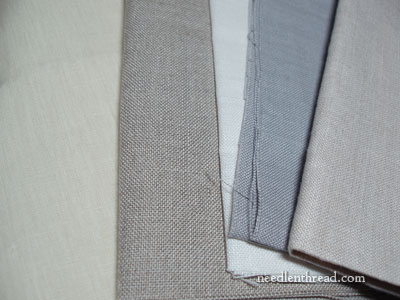
Why ground fabric first? Why not colors or types of thread?
Well, the way I see it, and I don’t know if I’m necessarily “right” or if other people go about the planning of projects this way, is that the colors of thread that you choose for a project will look decidedly different, depending on the color of your ground fabric. I suppose if you always stitch on white, then it doesn’t matter as much. But for this project, I’m not so sure I want to stitch on stark white.
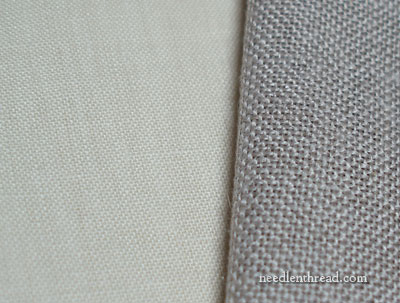
I’m leaning towards naturals and creams, and when it comes to naturals and creams, there’s a whole range of shades, really.
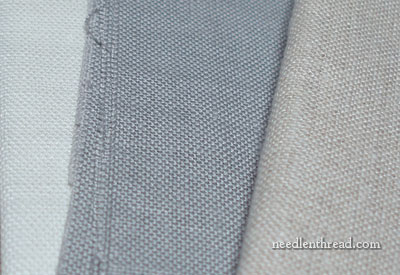
I also admit, I’m quite taken with the Puritan Grey in the center above, but I don’t think the weave of the fabric is exactly what I want.
The fabrics here are a combination of Legacy linens and Strathaven linens – both excellent linens for surface embroidery. In the photo above, the natural Strathaven on the right is nice, and I find myself going back to that one. Two photos up, the finer weave linen on the left is also in the running. You can see the difference in colors and weave between those two. So I need to take that into consideration in the decision-making process.
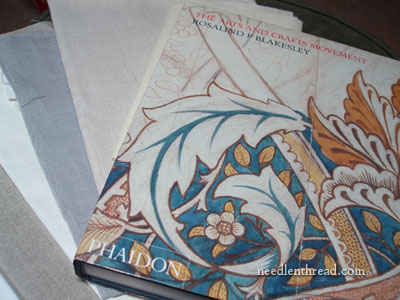
While looking over fabrics, I’m also doing a bit of reading and exploring. The design I’m working on is a spin-off of a drawing by an artist from the Arts & Crafts Movement (Selwyn Image), and so I’m reading up a bit on the movement. This particular book is The Arts and Crafts Movement by Rosalind Blakesley, and it’s the one I’ve been stuck into for the last week. I’ve got several more books on my shelf that focus on this era, and I’ll be delving into them as well.
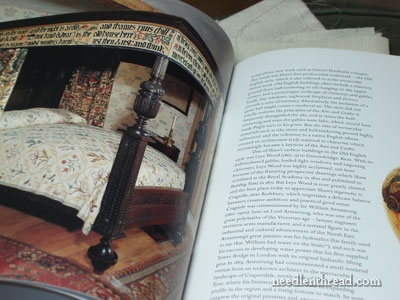
And besides reading, of course, I like to look at the pictures!
So that’s the first phase of planning for me, after the design has been drawn. What about you? How do you go about planning your projects? What are your first steps, once you have a design down? Do you just dive right in with what you have? Do you test various options in threads and fabrics? Do tell, do tell!







Well my natural inclination is to dive right in, but that’s exactly what I’m learning not to do in doing my City & Guilds Embroidery Course! I’m learning to develop samples first, test things out, take the good bits from them all and stick them together in a final product … that’s the theory … but I’m still inclined to just ‘go for it’!
Good luck in your decision process.
Wonderful book that – I have it too. Very readable and very informative!
Hi Mary! I love the Arts & Crafts style too, I can’t wait to see what the design is you are going to be working on. When I prep a project, I pick out the image I want and either edit it in photoshop or by hand and then I use my ‘light box’ (just a box with a lamp stuck in it) to transfer the image, then I search through my fabric bag and find something that would work, which is usually some muslin and then I pick out a color scheme and find all the threads that fall into that, then I place the skeins onto the fabric together to see how it looks. I usually don’t even figure out what stiches I am going to use until I start stiching. I am working on a project now, and it is the first time I have put forward a lot of effort into planning the stiches and coloring (I even have a notebook!), and I am enjoying the results. I don’t have a huge supply of fabrics to choose from yet. I would love to get some linen to work on, but I was completely unaware of how expensive it is to buy. I am looking forward to see the progress on this project!
I haven’t done much designing of my own, so have little experience to draw upon. I can see the logic of selecting the fabric first. I think there is more flexability choosing threads to go with a give fabric than the other way around.
I can’t wait to see what you are going to be doing and, to answer your question on an earlier post, I do enjoy seeing the planning stage.
Interesting, my inner 2-year-old would say grab the crayons and then find something to draw on. My (mostly) grown-up self can see the wisdom of finding the right background first, then pick the crayo-I-mean threads. Not that I actually DO that.
Do you ever dye your own fabric if you can’t find the color in the weave/fabric you want, Mary? Or is there enough variety among different companies that a suitable fabric can be found. Or if not, do you adjust the project to what’s available?
G’day Mary,
I found this post on the fabrics conductive of constructive thoughts.
I usually choose a fabric first but the particular fabric is probably chosen more for it’s appeal to my taste rather than it’s suitability for the design or project! From now on I’ll consider the other elements as well as personal appeal.
Colour for the threads is a hurdle if my son isn’t here to help me. But once that’s sorted I dive in, in slow motion! More of a “see how we go with it mate” sort of attitude and lots of umming and ahing. I tend to problem solve along the way rather than do samples first.
I should have a bumper sticker for my needlework bag that says “Don’t follow me, I’m stitching for trouble”!
Cheers, Kath
Mary, you might be familiar with this site. Well, maybe not so much this site but the couple represented in this particular shoot. My son brought my attention to it.
If you get to have a look, note the fabulous chair he has designed and she, Erica Wilson, has embroidered in Crewel work.
You’ll see her embroidery designs further down too.
Both their web sites are at the very bottom. Erica has designed some clever embroideries for kits.
Go into the blog on his web site and have a look at the copper needle and thread wind vane he has made for his wife, Erica. It’s so good. It’s not real far down the blog but the first part about needle workers is worth reading. And the cartoons are great.
http://theselby.com/6_310_10_VladEricaKagen/
Cheers, Kath
First I’d like to say that – yes – I’m all there about Arts & Crafts – I love the feel and the styles. Graceful and intriguing to the eye. Deceptively simple – joyful and fresh while being gently nostalgic. After the high ornamentalism of the Victorians and Edwardians art and design broke free and reinvented themselves to a style at once homey and cozy while being intriguing and inventive. Okay – I could go on and on about this.
As for design planning – When I get an idea for a design, I collect a whole series of images from books and from image files on the web. Once I find a picture or series of pictures that feel like I want things to look, I work up the design in PCStitch since I do a lot of cross stitch and petit point. I work with several images until I get the feel of what I want into the space I have set up and go from there setting up the colors and borders. But the colors on the computer screen are never quite the same as ones in real life under real light, so the next step is getting out my floss boxes and sitting by a sunny window to fiddle with the colors until they are all right with the piece and each other.
Its the nature of the project that determines what kind of fabric I use. If I am making pin cushions or smalls, I favor cotton floss on Aida cloth or hardanger fabric for its tight structure, washability and durability. I expect smalls to get a lot of use and wear and I want them washable after life in the work box. Linen, especially evenweave linen doesn’t have the firm feel I like and tends to get small pulls in the weave after a while. But if I am doing samplers, bell pulls or similar pieces that don’t get a lot of hand wear, linen is so lovely and agreeable and partners so well with silks. So its finding a balance with materials and purpose.
So I guess for me planning a project is a juggling and balancing act bringing images, fabrics and fibers into agreement with each other all before I sit down to stitch. But the true test of a design or project comes in the working. Sometimes no matter how careful you are with planning it doesn’t come out like you want it in the execution. The last stage of a project is not being afraid to take something out if it doesn’t work.
well so far I have just chosen a design that I like and then see what materials I have to hand…until I can build a some supplies.
In the mean time I have plumped for a kit that has everything ready to go but I do look forward to the day when I can put together my own projects from my own stock of supplies:-)
Alison.
My first inclination is to choose by color and then I dive right in. I don’t like to test but then I have had some false starts…
hi mary,
most of the time i just grab any white fabric i have and go. but i will be doing simple things like birthday cards or sachets. recently i’ve been working on some hardanger and you can’t just grab with that. i had several projects i wanted to do out of Creative Embroidery And Cross Stitch out of australia. i don’t have a needlework shop close to me and so i had to drive a distance. i wanted to get a couple of projects at the same time. the problem was they didn’t have the exact material called for in the patterns. so i like you was faced with looking at my threads and the colors they had in the counts i needed. nothing was perfect and it came down to the best of, but all in all i am pleased. the first thing i am going to make is a marken mouse out of Inspirations #59 for my step step mother’s birthday on the 27th. at the moment though i am desperately trying to finish the four seasons with an embroidered poem by myself for my husbands and my 30th anniversary which is the 20th. i might get the seasons done but i doubt i will get the poem done. the seasons is from Inspirations #31. hundreds of french knots. i owe you a thank you for your embroidery stitch how to video on them. my mother taught me the wrong way to do them and it was taking me three times the amount of time to do than you do.
terri sue
For me it is all about the colors (ground fabric and threads) to create the “aura” around the design as I see it in my head. The “in my head” stuff is pretty intangible, but I can be amazed when the right combo of stuff lands on the right color fabric. It just has “the feel.” Sometimes I will will recognize “the feel” somewhere else (like a magazine ad, photograph, printed fabric, or something), and I then use that to coordinate my materials.
If I dig deep enough, stitches can start appearing, too. This is all under ideal conditions, of course!! There are plenty of times I can get close, begin the project, and have to tweak (and rip!!) all along the way. Just part of the journey.
The A&C Movement is a Big subject (which I love), with a lot of contributors. Selwyn was from the Aesthetic Movement, which was the beginning. Traditionally, those colors were more green & bluish stuff (as opposed to the pearly pinks and grays of The Glasgow School). I can’t wait to see what you do!!!
I love the picture of the bed, that would be my dream bed 🙂
It depends on whether it is a project picked up on a whim or whether it has a use, or an intended place to be when it is finished. In the latter case, I suit the ground fabric to where it is going to live and work up from there…
I would like to know where you purchase your Legacy and Strathaven linens.
Thanks.
LB
Hi, Louise – I get them through Hedgehog Handworks. The prices are fair (same as anywhere else), and the service is excellent. Occasionally, Hedgehog runs sales (like in January of this past year, when they had a 15% off sale) and this is when I “stock up.” But in between times, when I need fabric for a special project, I order from them, too. ~MC
I am more of a dive in kind ofembroiderer, up to a certain point. That said, I am extremely strict that colour combinations should be perfect, so if I really miss something in my supplies, I will wait until I can get it. I chose the colours of the thread and fabric together as I seldom stitch on white, and rather like deep coloured backgrounds. As for the kind of fabric it will really depend on what I have at hand and what I mean to do with the thing, although I have been known to embroider a motive because I liked it and then decide what to do with it based on the stuff it was made of.
I always draw my own patterns so I don’t have to dig around for pictures, which is a great relief.